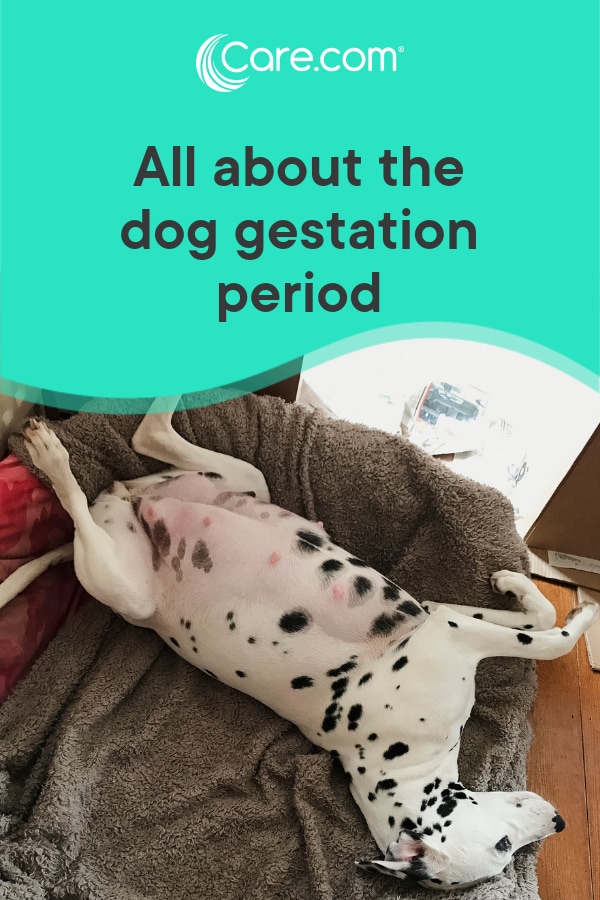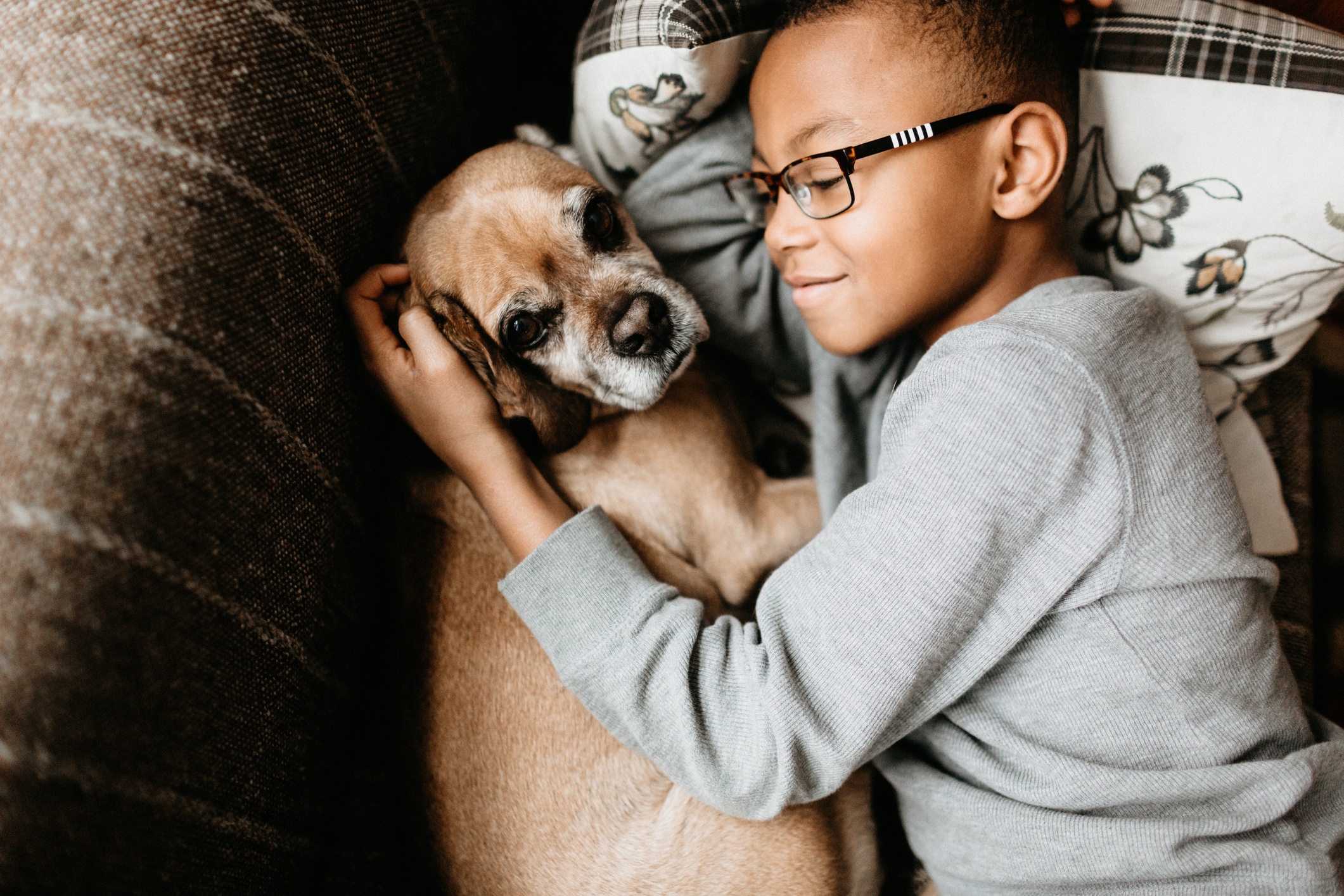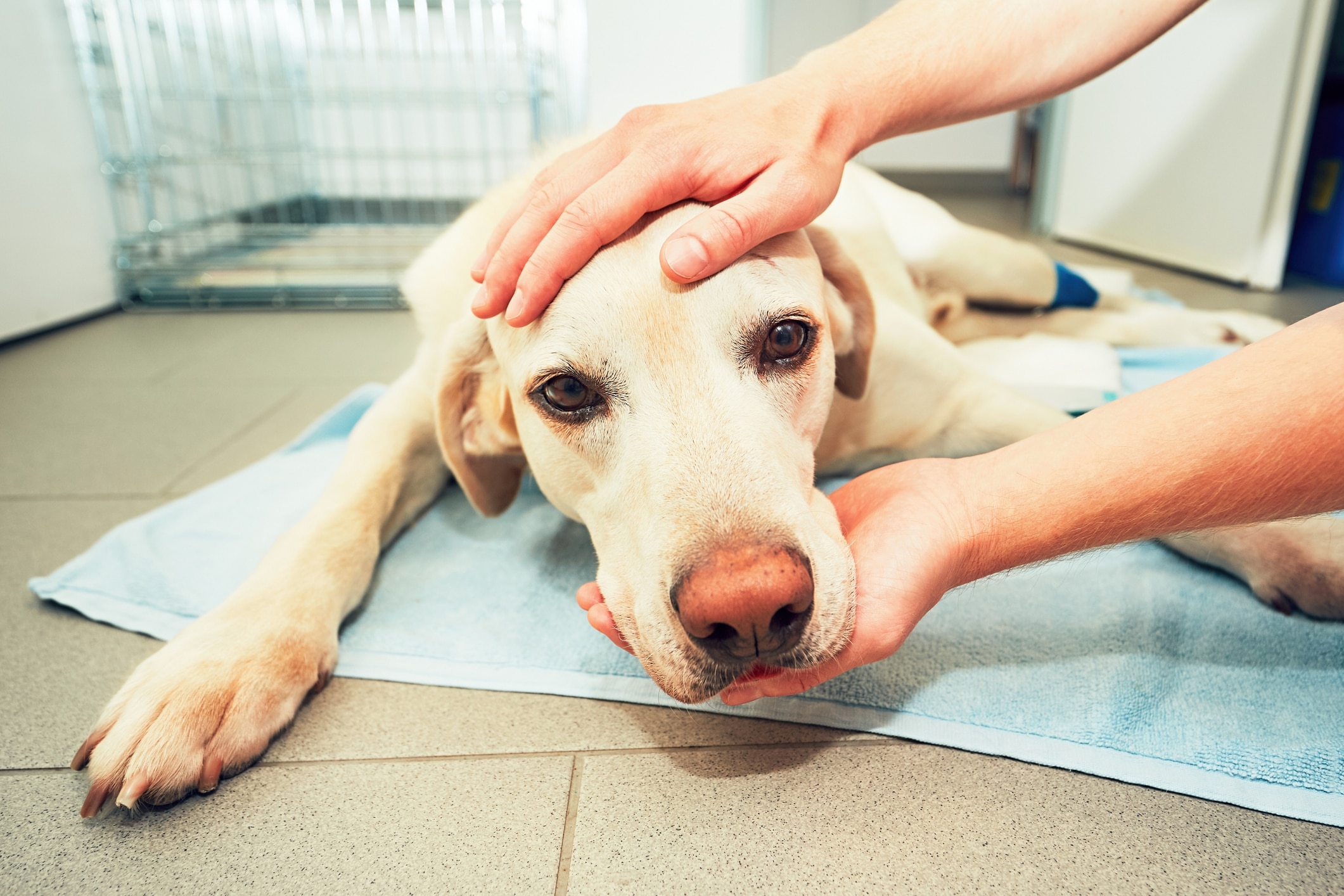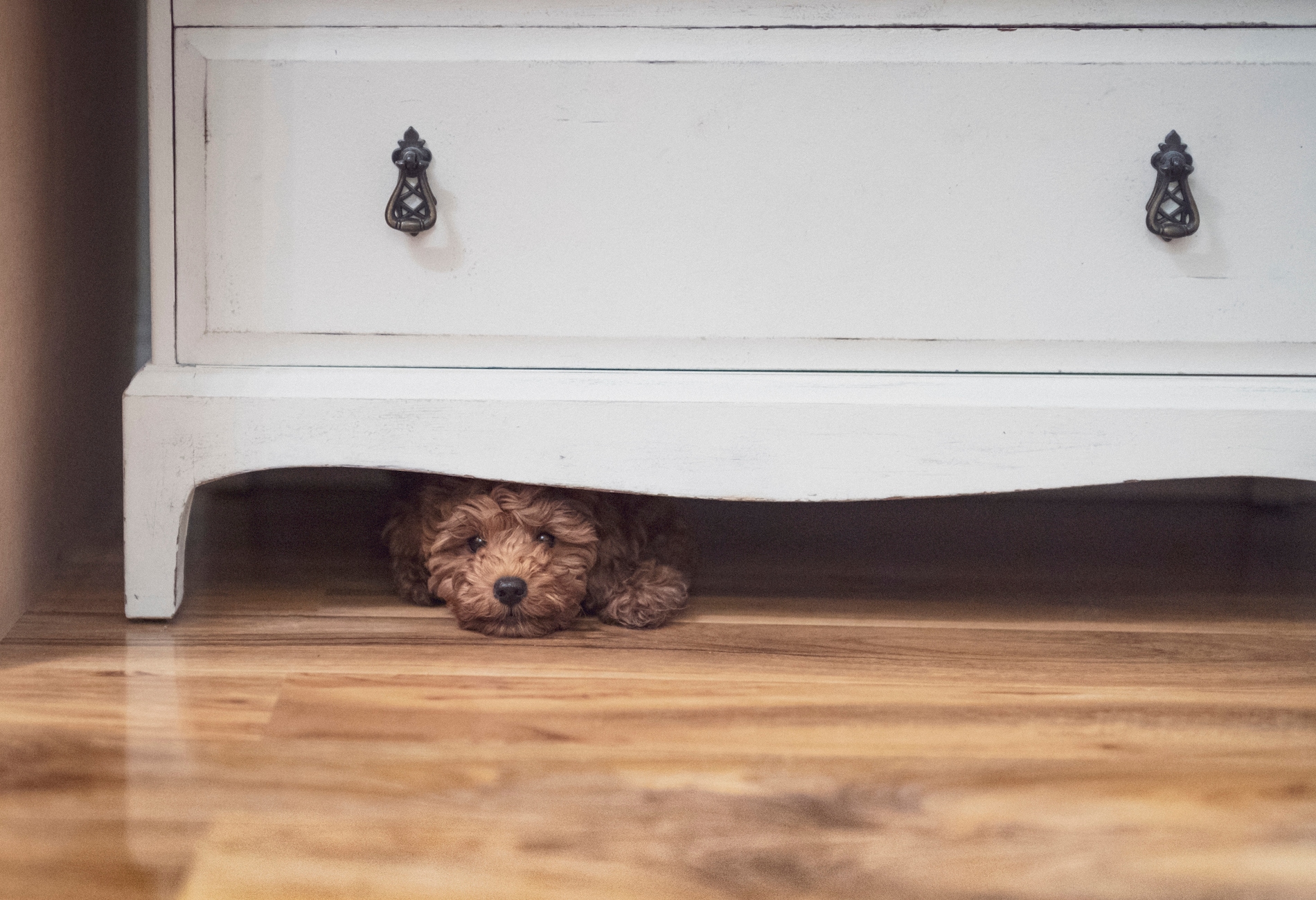Are congratulations in order? If your dog is about to become a mom, the dog gestation period can be equally exciting and nerve-racking.
Like any first-timer, you’ll have questions that need answers — such as, how long are dogs pregnant, how do you care for a pregnant dog and what is needed in preparation for the blessed event?
First things first, your veterinarian can confirm whether puppies are, in fact, on the way and help you prepare for the changes in the weeks ahead. To guide you through the dog gestation period, we’ve compiled this guide of what to expect — beyond a perfect pile of adorableness — when you’re expecting puppies.
How long is the gestation period for dogs?
“The entire gestation period is approximately nine weeks, or 63 days, although it can range from 58 to 68 days, depending on your dog,” says Missouri dog breeder Kristi Waterworth.
The dog gestation period, as it’s formally called, begins when your female dog becomes pregnant and lasts until she delivers her healthy puppies.
Symptoms of pregnancy
During the early weeks of pregnancy, it may be business as usual for your pooch, as she may not show many outward signs. Dr. Carol Margolis, a lecturer in pediatrics, genetics and reproduction for the School of Veterinary Medicine at the University of Pennsylvania, says as the dog’s pregnancy progresses, you may notice:
- Occasional short-lived episodes of vomiting.
- Loss of appetite for duration of pregnancy or ravenous appetite.
- Abdominal distention.
- Mammary gland development.
- Slightly pale mucous membranes (pale pink gums, as opposed to their normal pink) due to the physiologic anemia associated with pregnancy.
How to care for your pregnant dog
To ensure the most healthy gestation period possible, it’s important that your dog is under a veterinarian’s care throughout her pregnancy.
“Depending on the age of the dog at the time of breeding, different breed health screening and general systemic health screening will be recommended,” says Margolis. “The dog should be negative for infectious diseases and in general good health and at a good weight.”
Just as humans are mindful of what they eat when they’re pregnant, dogs need to be, too. (Thankfully, they have you to mind their meals for them.)
“They should be maintained on an appropriate dog food. We recommend dogs on raw diets be switched to kibble during breeding, pregnancy and lactation to reduce chances of abortions and neonatal losses,” Margolis says. “At the time of pregnancy diagnosis, we will recommend to feed the puppy variety of the dog kibble and to increase the amount fed by 50 percent, but at smaller quantities and more frequently. Doing this avoids the necessity to supplement with any vitamins or nutraceuticals that can be harmful during pregnancy.”
Margolis recommends regular deworming and parasite prevention, but it’s important to use products approved for use during pregnancy and lactation. She does not recommend any supplements during dog pregnancy “unless otherwise indicated by a diagnosed problem.”
Fish oils, she adds, have been shown to be beneficial, but appropriate quantities are found in most of the AAFCO (Association of American Feed Control Officials) approved puppy foods that she recommends feeding your pregnant dog.
The importance of your dog’s health during pregnancy
On a scale from one to 10 — 10 being extremely important — how critical is it that your dog maintain good health during pregnancy? The answer is, of course, 10.
“Maintaining health and fitness are important, and we usually allow the female to set her own pace of usual exercise and activity,” Margolis says. “We recommend restricting strenuous exercise.”
“Maintaining health and fitness are important, and we usually allow the female to set her own pace of usual exercise and activity.”
—Dr. Carol Margolis, lecturer in pediatrics, genetics and reproduction, the School of Veterinary Medicine, University of Pennsylvania
If your dog isn’t healthy, problems can arise during pregnancy and whelping, the term for puppy birth.
“Obesity can lead to issues during natural whelping, increase neonatal mortality and lowers fertility in general,” Margolis says. “Orthopedic diseases may predispose [your dog] to pain and development of arthritis experienced during the pregnancy. Even dogs in perfect health can develop endocrine-related problems during pregnancy, such as pregnancy diabetes or pregnancy toxemia.”
Margolis provided this list of potential emergencies during pregnancy. Contact your veterinarian if you observe the following:
- Extreme lethargy (listlessness).
- Complete loss of appetite (unless within 24 hours of giving birth).
- Bloody vaginal discharge.
- Foul smelling, yellowish or green discharge.
- Vomiting (more than just “morning sickness”).
- Fever.
- Extreme abdominal pain.
- Very pale (white) gums.
Preparing your dog and her whelping box for birth
Choose a quiet, calm area where your dog can give birth, and prep a whelping box where she can comfortably sit.
“Having a private area with a whelping box that is kept clean to control general sanitation and infectious diseases at appropriate temperature and humidity are a good start,” Margolis says. “Keep environmental temperatures of 85 degrees (Fahrenheit) and humidity of 55 to 65 percent for the first two weeks [after delivery].”
“Having a private area with a whelping box that is kept clean to control general sanitation and infectious diseases at appropriate temperature and humidity are a good start.”
—Dr. Carol Margolis
It’s also wise to have your veterinarian on speed dial should problems pop up.
“Being familiar with your regular veterinarian and the closest emergency facility are important things to keep in mind if at any time things do not appear to be going smoothly,” she says.
Plan to introduce your dog to the whelping box and birthing room during the last three weeks of gestation, Margolis says. This confinement will limit her exposure to other animals and infectious diseases.
“The box should be large enough for her to move away from the pups (and) easy for her to get in and out but small enough to keep the pups confined,” she says. “Bedding should be provided and changed daily, while other animals are kept from entering the maternity area.”
Things you’ll need for the birth
You can never be too prepared for this big event. Margolis suggests these items (but you may need more):
- Lubricants. These are used to lubricate vaginal canal if assisting with manual manipulation in the case of a stuck puppy (done at owner’s or veterinary discretion).
- Warm, small towels. Use these to dry neonates off, as they lose body temperature very quickly when wet and can not regulate their own body temperatures.
- Suction bulbs. Remove excess fluid from the nose and mouth of the puppies with these.
- Heat sources. Neonates can’t regulate their own temperature, so having a heated blanket, lamps, water bottles/gloves with warm water, etc. is important.
- Puppy box with heat support. If you need to assess or provide additional care for a neonate, provide a safe and warm place for them while the mom continues birthing process.
- Hemostats and small scissors with suture or floss string for umbilical cords. If mom’s not removing sacs and biting off cords, you have to do it. Use hemostats and scissors, tying off about 1 to 2 centimeters from the body wall, then dipping the end in the tincture of iodine to reduce the incidence of ascending bacterial infection.
- Tincture of iodine, 2 percent. This can be used as a topical antiseptic for superficial cuts, wounds, etc.
- Bowls for warm water baths. If they are becoming chilled, you can put a neonate with head out in a plastic bag so they don’t get wet, and then into the water bath to warm them to temp (minimum feeding temp for a neonate is 96 degrees Fahrenheit).
- A gram scale. Weigh pups daily and ensure they are gaining weight. They should be gaining about 10 percent in body weight daily.
Additional items or medications may include:
- An oxygen source, as heart rate in newborns is dependent on oxygen.
- Neonatal stethoscope to listen if heartbeat is detectable to direct how aggressive to be with resuscitation efforts.
- Small-gauge needles for the nasal acupuncture point to stimulate respiration/breathing.
- Dilute dextrose, as the pup may need sugar orally for energy source while awaiting colostrum or first milk.
- Dilute epinephrine to stimulate heart if difficult resuscitation.
- Injectable ceftiofur, an antibiotic, if there’s obvious infection or cause for concern.
Some owners will also have calcium and oxytocin (to increase uterine contractility for fetal ejection), but these are best used under veterinary instruction and supervision.
Determining when labor is about to take place
Week nine is the long-awaited end of the dog gestation period. The rectal temperature of your dog will drop a full one or two degrees six to 18 hours prior to birth, signaling it’s time to get ready for the big event.
“If a temperature drop is observed and labor does not begin within 24 hours, she should be examined by a veterinarian,” Margolis says. “There is a decrease in serum progesterone just before whelping, which causes a transient drop in rectal temperature in 80 percent of dogs. We usually recommend monitoring twice daily, beginning the last two weeks of gestation, to establish a baseline.”
The pet owners’ responsibilities during birth
Your dog will be doing all the hard work, but owners can help by keeping a close eye on what’s going on and offering support, if needed.
“The best ways most owners can help during the birthing process is to know when to be calm and patient and to know when to intervene,” she says. “For example, if the puppy is born and the mom is not very quick to remove the fetal membranes, the owner can assist in breaking the membrane, suction-bulbing fluid from the mouth and nose, drying vigorously with the small warm towels, and tying off the umbilical cord, then returning to mom.”
Alternatively, if everything appears to be going well, it’s best to step back and let her do her thing.
“If she is doing everything well on her own, it’s best not to intervene,” Margolis says.
Warning signs to look out for during and after birth
Hopefully the birthing process will go smoothly for everyone and it will be complete within a matter of hours. But complications can happen, and Margolis shares some common warning signs owners should look out for.
Emergencies around the time of the expected birth:
- A drop in body temperature, and then the temperature rises again without any puppies being born.
- Green discharge before the birth of the first puppy.
- Visible contractions for more than a half hour without the birth of a puppy.
- More than two to four hours between puppies after one puppy has already been born.
- Increased amount of bloody discharge that doesn’t stop.
After whelping, it is recommended that you monitor the following:
- Daily weight check of pups.
- Daily mammary gland check of mom.
- Temperature check of mom for three days after whelping.
“If any vomiting (more than once), lack of appetite, poor mothering, poor pup weight gain or any abnormal signs other than mom taking good care of pups, they should be evaluated by a veterinarian,” says Margolis. “Complications can include mastitis, metritis, eclampsia, etc.”
If you notice any unusual behavior or troubling symptoms not covered here, be sure to contact your veterinarian to make certain you have a healthy and happy mother and new litter of puppies.
Read next: How to take care of a new puppy






